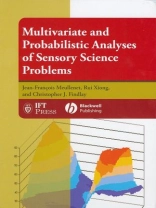Sensory scientists are often faced with making business decisions based on the results of complex sensory tests involving a multitude of variables. Multivariate and Probabilistic Analyses of Sensory Science Problems explains the multivariate and probabilistic methods available to sensory scientists involved in product development or maintenance. The techniques discussed address sensory problems such as panel performance, product profiling, and exploration of consumer data, including segmentation and identifying drivers of liking.
Applied in approach and written for non-statisticians, the text is aimed at sensory scientists who deal mostly with descriptive analysis and consumer studies. Multivariate and Probabilistic Analyses of Sensory Science Problems offers simple, easy-to-understand explanations of difficult statistical concepts and provides an extensive list of case studies with step-by-step instructions for performing analyses and interpreting the results. Coverage includes a refresher on basic multivariate statistical concepts; use of common data sets throughout the text; summary tables presenting the pros and cons of specific methods and the conclusions that may be drawn from using various methods; and sample program codes to perform the analyses and sample outputs.
As the latest member of the IFT Press series, Multivariate and Probabilistic Analyses of Sensory Science Problems will be welcomed by sensory scientists in the food industry and other industries using similar testing methodologies, as well as by faculty teaching advanced sensory courses, and professionals conducting and participating in workshops addressing multivariate analysis of sensory and consumer data.
สารบัญ
Introduction 3
Chapter 1 A Description of Sample Data Sets Used in Further Chapters 9
1.1 A Description of Example Data Sets 9
References 25
Chapter 2 Panelist and Panel Performance: A Multivariate Experience 27
2.1 The Multivariate Nature of Sensory Evaluation 27
2.2 Univariate Approaches to Panelist Assessment 29
2.3 Multivariate Techniques for Panelist Performance 32
2.4 Panel Evaluation through Multivariate Techniques 43
2.5 Conclusions 46
References 47
Chapter 3 A Nontechnical Description of Preference Mapping 49
3.1 Introduction 49
3.2 Internal Preference Mapping 49
3.3 External Preference Mapping (PREFMAP) 58
3.4 Conclusions 66
References 67
Chapter 4 Deterministic Extensions to Preference Mapping Techniques 69
4.1 Introduction 69
4.2 Application and Models Available 69
4.3 Conclusions 89
References 94
Chapter 5 Multidimensional Scaling and Unfolding and the Application of Probabilistic Unfolding to Model Preference Data 95
5.1 Introduction 95
5.2 Multidimensional Scaling (MDS) and Unfolding 96
5.3 Probabilistic Approach to Unfolding and Identifying the Drivers of Liking 98
5.4 Examples 100
References 109
Chapter 6 Consumer Segmentation Techniques 111
6.1 Introduction 111
6.2 Methods Available 111
6.3 Segmentation Methods Using Hierarchical Cluster Analysis 113
References 126
Chapter 7 Ordinal Logistic Regression Models in Consumer Research 129
7.1 Introduction 129
7.2 Limitations of Ordinary Least Square Regression 129
7.3 Odds Odds Ratio and Logit 130
7.4 Binary Logistic Regression 133
7.5 Ordinal Logistic Regression Models 144
7.6 Proportional Odds Model (POM) 144
7.7 Conclusions 160
References 160
Chapter 8 Risk Assessment in Sensory and Consumer Science 163
8.1 Introduction 163
8.2 Concepts of Quantitative Risk Assessment 164
8.3 A Case Study: Cheese Sticks Appetizers 166
8.4 Conclusions 176
References 176
Chapter 9 Application of MARS to Preference Mapping 179
9.1 Introduction 179
9.2 MARS Basics 179
9.3 Setting Control Parameters and Refining Models 187
9.4 Example of Application of MARS 188
9.5 A Comparison with PLS Regression 201
References 205
Chapter 10 Analysis of Just About Right Data 207
10.1 Introduction 207
10.2 Basics of Penalty Analysis 208
10.3 Boot Strapping Penalty Analysis 210
10.4 Use of MARS to Model JAR Data 212
10.5 A Proportional Odds/Hazards Approach to Diagnostic Data Analysis 215
10.6 Use of Dummy Variables to Model JAR Data 220
References 233
Index 237
เกี่ยวกับผู้แต่ง
Jean-François Meullenet, Ph.D., is associate professor of Sensory Science in the Department of Food Science at the University of Arkansas, Fayetteville, AR. Dr. Meullenet conducts research in the area of sensory science and his expertise encompasses sensory and consumer science, rheology and modeling of food perception. Rui Xiong, Ph.D., is a research scientist with the Consumer Science Insights, Unilever Home & Personal Care, Trumbull, CT, USA. Christopher J. Findlay, Ph.D., is president of Compusense, Inc., Guelph, Ontario, Canada. He is associate editor for sensory evaluation for Food Research International.












